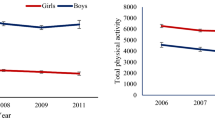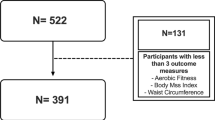Abstract
OBJECTIVE: To describe physical activity (PA) and inactivity levels of Filipino youth aged 14–16 y.
DESIGN: PA type and patterns were assessed in an adolescent cohort enrolled in the Cebu Longitudinal Health and Nutrition Survey.
SUBJECTS: A total of 1053 males (aged 15.6±0.5 y; body mass index (BMI)=18.6±2.6 kg/m2) and 990 females (aged 14.6±0.5 y; BMI=18.8±2.4 kg/m2).
MEASUREMENTS: PA was assessed by (1) self-reported usual PA (questionnaire); (2) 24-h objective monitoring (Caltrac accelerometer); and (3) 24 h recalls of PA during the objectively monitored time frame.
RESULTS: As measured by Caltrac, males expended 378.0±164.5 kcal and females 271.0±105.4 kcal. The measurement approaches employed agreed in expected ways, given the limitations of each. Together the approaches used indicated that the primary sources of PA for this population are chores and active commuting. In all, 40% of the sample walked to school, less than 1% rode a bicycle, 22% rode in/on motorized transport, and 37% used some combination of walking and motorized transport. Further, gender differences exist for type, frequency, and duration of physical activities performed by Filipino youth. Specifically, females report engaging in few leisure-time physical activities and more household chores. In total, 48% of Filipino youth report watching ≥2 h/day of television; relatively few youth (7%) report watching >4 h/day at this time. An 18% of males report no vigorous activities compared to 87% of females.
CONCLUSION: Clear gender differences in PA patterns and levels exist in Filipino adolescents. Nonsport/exercise type activities (eg chores and active commuting) currently provide a large proportion of daily activity for both males and females, however. It is anticipated that as modernization and technological advancement continue in this developing country, these primary sources of PA will decrease.
This is a preview of subscription content, access via your institution
Access options
Subscribe to this journal
Receive 12 print issues and online access
$259.00 per year
only $21.58 per issue
Buy this article
- Purchase on Springer Link
- Instant access to full article PDF
Prices may be subject to local taxes which are calculated during checkout
Similar content being viewed by others
References
Popkin BM, Doak CM . The obesity epidemic is a worldwide phenomenon. Nutr Rev 1998; 56: 106–114.
Wang Y, Monteiro C, Popkin BM . Obesity trends in older children and adolescents. Am J Clin Nutr, in press.
Benefice E . Physical fitness and body composition in relation to physical activity in prepubescent Senegalese children. Am J Hum Biol 1998; 10: 385–396.
Torun B, Davies PSW, Livingstone MBE, Paolisso M, Sackett R, Spurr GB . Energy requirements and dietary recommendation for children and adolescents 1 to 18 years old. Eur J Clin Nutr 1996; 50: S37–S81.
Adair LS, Kuzawa C, Borja JR . Maternal energy stores and diet composition during pregnancy program adolescent blood pressure. Circulation 2001; 104: 1034–1039.
Sallis JF . Age-related decline in physical activity: a synthesis of human and animal studies. Med Sci Sports Exerc 2000; 32: 1598–1600.
Garnier D, Benefice E . Habitual physical activity of Senegalese adolescent girls under different working conditions, as assessed by a questionnaire and movement registration. Ann Hum Biol 2001; 28: 79–97.
LaMonte MJ, Tudor-Locke C, Ainsworth BE . Physical activity. In: Anderson R (ed). Obesity: etiology, assessment, treatment, and prevention. Human Kinetics: Champaign, IL, in press.
Tudor-Locke CE, Myers AM . Methodological considerations for researchers and practitioners using pedometers to measure physical (ambulatory) activity. Res Q Exerc Sport 2001; 72: 1–12.
Ainsworth BE, Haskell WL, Whitt MC, Irwin ML, Swartz AM, Strath SJ, O'Brien WL, Bassett DR, Schmitz KH, Emplaincourt PO, Jacobs DR, Leon AS . Compendium of physical activities: an update of activity codes and MET intensities. Med Sci Sports Exerc 2000; 32: S498–S504.
Pate RR, Pratt M, Blair SN, Haskell WL, Macera CA, Bouchard C, Buchner D, Ettinger W, Heath GW, King AC, Kriska A, Leon AS, Marcus BH, Morris J, Paffenbarger RS, Patrick K, Pollock ML, Rippe JM, Sallis J, Wilmore JH . Physical activity and public health: a recommendation from the Centers for Disease Control and Prevention and the American College of Sports Medicine. JAMA 1995; 273: 402–407.
Wong TC, Webser JG, Montoye HJ, Washburn R . Portable accelerometer device for measuring human energy expenditure. IEEE Trans Biomed Eng 1981; BME-28: 467–471.
Montoye HJ, Washburn R, Servais S, Ertl A, Webster JG, Nagle FJ . Estimation of energy expenditure by a portable accelerometer. Med Sci Sports Exerc 1983; 15: 403–407.
Anderson RE, Crespo CJ, Bartlett SJ, Cheskin LJ, Pratt M . Relationship of physical activity and television watching with body weight and level of fatness among children: results from the Third National Health and Nutrition Examination Survey. JAMA 1998; 279: 938–942.
Welk GJ, Corbin CB, Dale D . Measurement issues in the assessment of physical activity in children. Res Q Exerc Sport 2000; 71: 59–73.
Ainsworth BE, Haskell WL, Leon AS, Jacobs DR, Montoye HJ, Sallis JF, Paffenbarger RS . Compendium of physical activities: classification of energy costs of human physical activities. Med Sci Sports Exerc 1993; 25: 71–80.
Pratt M, Macera CA, Blanton C . Levels of physical activity and inactivity in children and adults in the United States: current evidence and research issues. Med Sci Sports Exerc 1999; 31: S526–S533.
Schmidt GJ, Walkuski JJ, Stensel DJ . The Singapore Youth Coronary Risk and Physical Activity Study. Med Sci Sports Exerc 1998; 30: 105–113.
Goran MI, Nagy TR, Gower BA, Mazariegos M, Solomons N, Hood V, Johnson R . Influence of sex, seasonality, ethnicity, and geographic location on the components of total energy expenditure in young children: implications for energy requirements. Am J Clin Nutr 1998; 68: 675–682.
Bar-Or O, Baranowski T . Physical activity, adiposity, and obesity among adolescents. Pediatr Exerc Sci 1994; 6: 348–360.
Rowlands AV, Eston RG, Ingledew EK . Measurement of physical activity in children with particular reference to the use of heart rate and pedometry. Sports Med 1997; 24: 258–272.
Tudor-Locke CE, Myers AM . Challenges and opportunities for measuring physical activity in sedentary adults. Sports Med 2001; 31: 91–100.
Kriska AM, Knowler WC, LaPorte RE, Drash AL, Wing RR, Blair SN, Bennett PH, Kuller LH . Development of questionnaire to examine relationship of physical activity and diabetes in Pima Indians. Diabetes Care 1990; 13: 401–411.
Ainsworth BE, Leon AS, Richardson MT, Jacobs DR, Paffenbarger RS . Accuracy of the college alumnus physical activity questionnaire. J Clin Epidemiol 1993; 46: 1403–1411.
Richardson MT, Leon AS, Jacobs DR, Ainsworth BE, Serfass R . Comprehensive evaluation of the Minnesota Leisure Time Physical Activity Questionnaire. J Clin Epidemiol 1994; 47: 271–281.
Armstrong N, Welsman J . Young people and physical activity. Oxford University Press: Oxford, UK; 1997.
Wang Y, Monteiro C, Popkin BM . Trends of obesity and underweight in older children and adolescents in the United States, Brazil, China, and Russia. Am J Clin Nutr 2002; 75(6): 971–977.
Acknowledgements
Data collection funding for the Cebu Longitudinal Health and Nutrition Survey (CLHNS) was provided by the Nestle Foundation, USAID under the MEASURE Project. Additional funding for file creation and analysis was provided by US National Institutes of Health (NIH) (R01-HD38700). Analysis funding for this grant was provided by the Scientific Affairs Division of M&M Mars though a subcontract to the University of South Carolina Prevention Research Center and the Department of Exercise and Wellness at the Arizona State University from the University of North Carolina Population Center.
Author information
Authors and Affiliations
Corresponding author
Appendix
Appendix
Rights and permissions
About this article
Cite this article
Tudor-Locke, C., Ainsworth, B., Adair, L. et al. Physical activity in Filipino youth: the Cebu Longitudinal Health and Nutrition Survey. Int J Obes 27, 181–190 (2003). https://doi.org/10.1038/sj.ijo.802207
Received:
Revised:
Accepted:
Published:
Issue Date:
DOI: https://doi.org/10.1038/sj.ijo.802207
Keywords
This article is cited by
-
Changes in blood pressure during the transition of retirement: the role of physical activity in China
Journal of Human Hypertension (2020)
-
Nutrition Transition and the Global Diabetes Epidemic
Current Diabetes Reports (2015)
-
Interaction between physical activity and sleep duration in relation to insulin resistance among non-diabetic Chinese adults
BMC Public Health (2012)
-
Secular trends: a ten-year comparison of the amount and type of physical activity and inactivity of random samples of adolescents in the Czech Republic
BMC Public Health (2011)
-
Cumulative incidence trends of selected cancer sites in a Philippine population from 1983 to 2002: a joinpoint analysis
British Journal of Cancer (2010)



